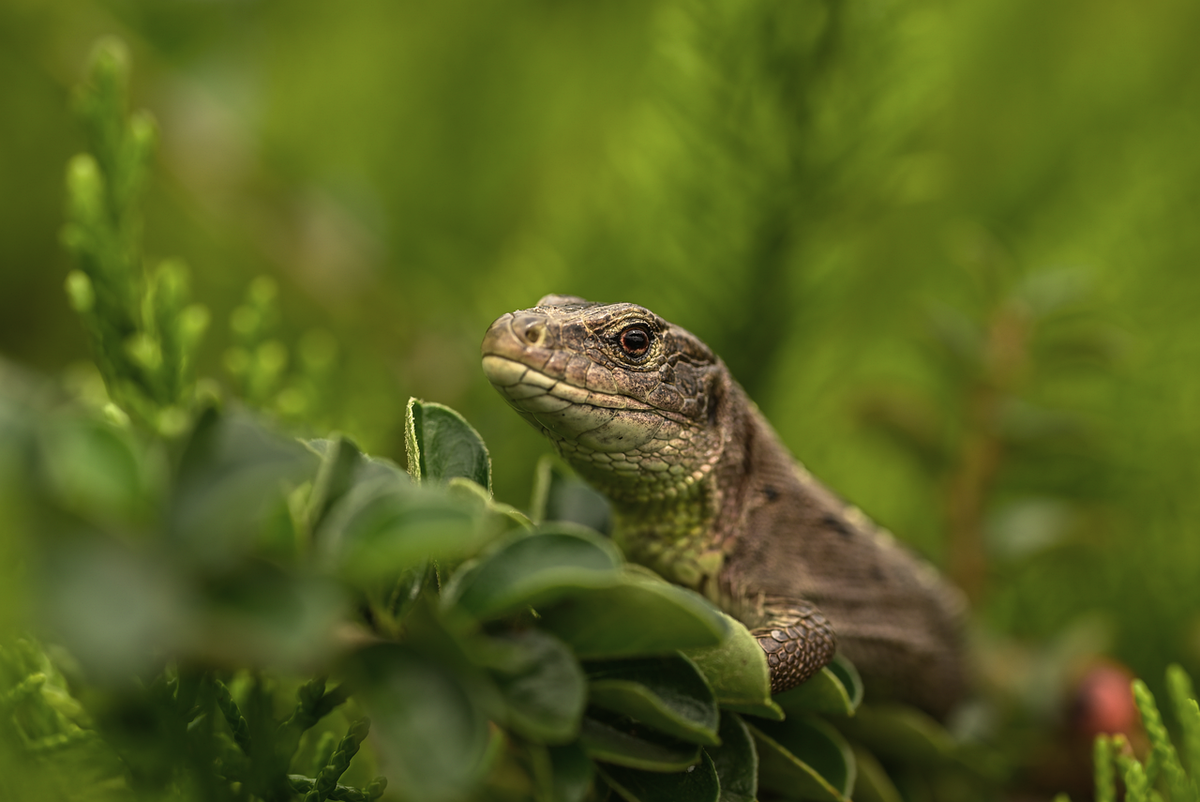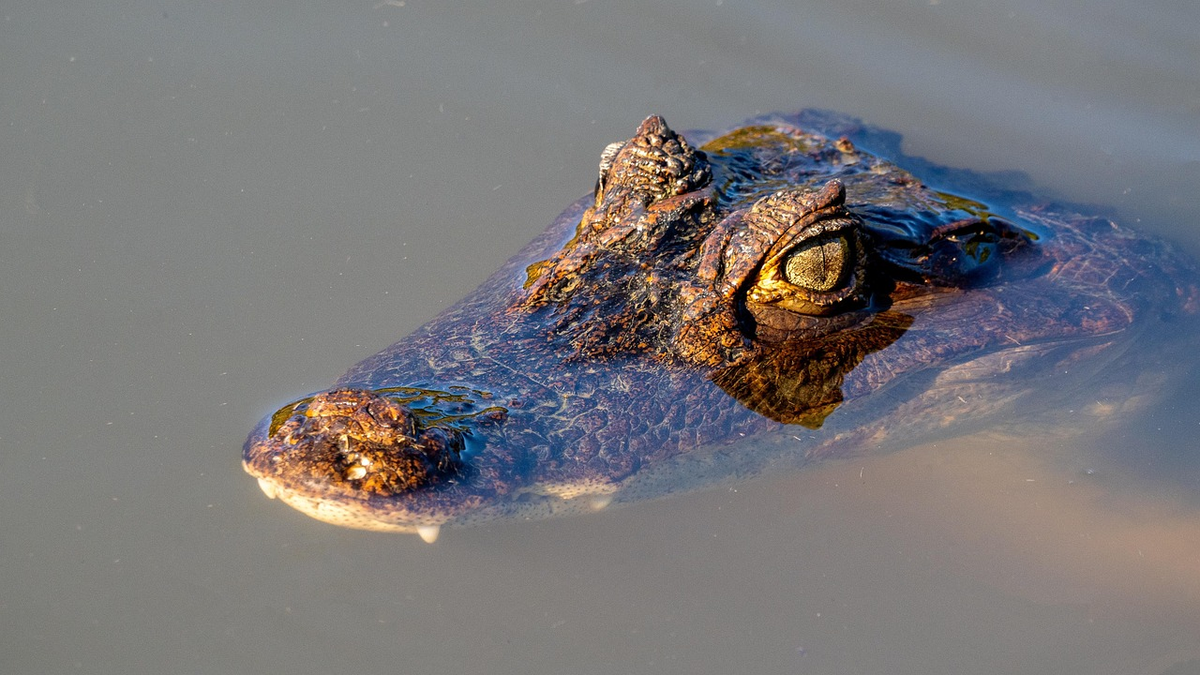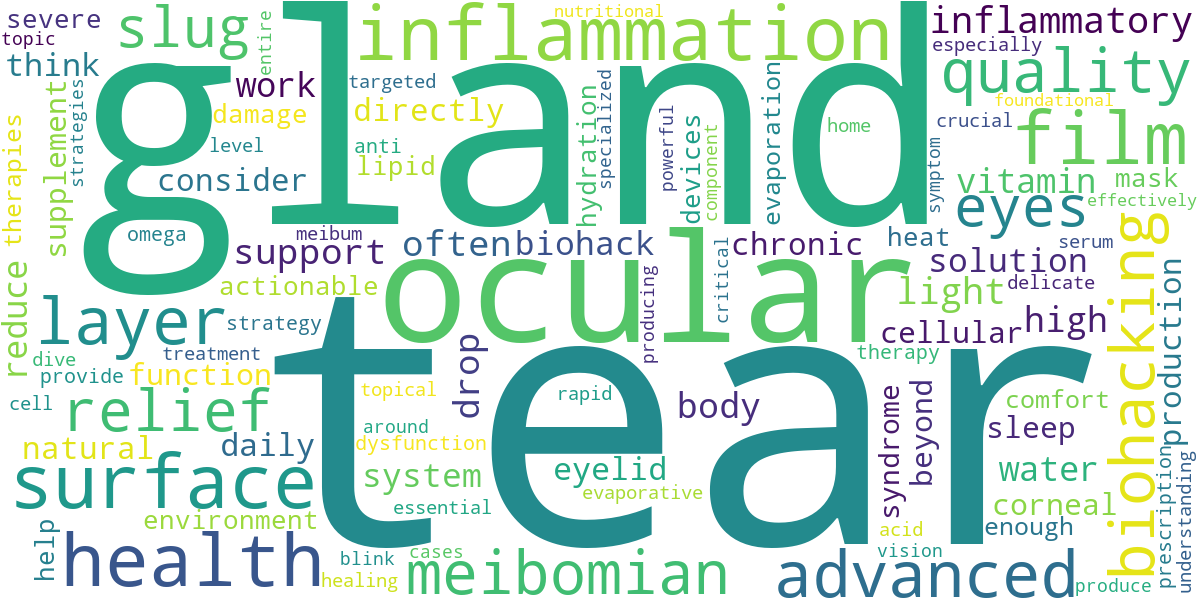
Are you one of the millions silently enduring the gritty discomfort, blurriness, and constant irritation of Dry Eye Syndrome, resigned to temporary fixes?
For a complete overview of this topic, refer to our main guide on Biohacking Vision: The Ultimate Guide to Eye Health & Clarity.
This definitive guide doesn’t just offer symptom management; it invites you to unlock the powerful potential of advanced biohacking strategies to address dry eye at its root, transforming your understanding and providing a pathway to lasting ocular comfort and clarity.
💡 Key Takeaways
- Uncover the multifaceted root causes of dry eye, moving beyond surface-level symptoms to truly understand your condition.
- Master a holistic, biohacking approach integrating targeted nutrition, internal supplements, and specialized topical solutions for comprehensive relief.
- Learn to optimize your lifestyle and environment, creating conditions that naturally support optimal tear film health and reduce irritation.
- Explore cutting-edge therapies and advanced devices, gaining insights into the latest innovations for profound and sustained dry eye management.
In This Article
- — 💡 Key Takeaways
- → 💡 Understanding & Fundamentals
- — 💧 The Dynamic Tear Film: Your Eye’s Liquid Shield
- — 🔍 Unpacking the Core Problem: More Than Just “Dryness”
- — 🔬 The Two Primary Flavors of Dry Eye Syndrome
- — 🔥 The Inflammatory Cascade: The Silent Destroyer
- → 💊 Internal & Nutritional Biohacks
- — 💧 Omega-3 Fatty Acids: The Lubricant Within
- — 🥕 Key Vitamins & Antioxidants: Your Ocular Shield
- — 🦠 The Gut-Eye Axis: Beyond the Obvious
- — 🌱 Specialized Compounds: Next-Level Support
- → 💧 Topical & Glandular Solutions
- — 💧 Topical Solutions: Direct Ocular Support
- — ⚙️ Glandular Solutions: Optimizing Your Natural Oil Production
- → 🏡 Lifestyle & Environmental Adjustments
- — 💻 Taming the Digital Eye Strain Beast
- — 💧 Humidifying Your Habitat
- — 🌬️ Navigating the Outdoors
- — 😴 Elevating Your Sleep Hygiene
- — 🥤 The Hydration Imperative
- → 🔬 Advanced Therapies & Devices
- — 🏥 In-Office Clinical Therapies: Re-Engineering Your Tear Film
- — ⚙️ How It Works
- — ⚙️ How It Works
- — 💊 Advanced Pharmaceutical Interventions: Targeting Inflammation & Production
- — ⚙️ How It Works
- — ⚙️ How It Works
- — 👁️🗨️ Specialized Ocular Devices: Beyond Standard Contact Lenses
- — ⚙️ How It Works
- — 🧬 Biologic & Regenerative Therapies: Harnessing Your Body’s Healing Power
- — ⚙️ How It Works
- — ⚙️ How It Works
- — 💡 Advanced At-Home Devices: Your Personal Biohacking Lab
- — ⚙️ How It Works
💡 Understanding & Fundamentals

You’ve likely experienced the gritty, burning, or watery sensations that define dry eye syndrome. But let’s be clear: this isn’t just a minor annoyance. It’s a complex, often debilitating ocular surface disease that, if left unaddressed, can significantly impact your vision, comfort, and overall quality of life. Thinking of dry eye as merely “not enough tears” is akin to describing a high-performance engine problem as just “not enough oil.” It’s far more nuanced, involving intricate biological systems that, when out of sync, create a cascade of discomfort.
💧 The Dynamic Tear Film: Your Eye’s Liquid Shield
To truly understand dry eye, you first need to grasp the elegance of your tear film. This isn’t just saltwater; it’s a meticulously layered, dynamic protective barrier that covers the surface of your eye with every blink. Think of it as a sophisticated, three-tiered defense system, each layer serving a critical function:
- ✅ The Mucin Layer (Innermost): This sticky, gel-like layer, produced by goblet cells in your conjunctiva, acts like a primer. It helps the watery layer spread evenly over the hydrophobic corneal surface, ensuring the tear film adheres perfectly, like a thin coat of paint on a wall. Without it, tears would bead up and run off.
- ✅ The Aqueous Layer (Middle & Thickest): Comprising mostly water, electrolytes, and vital proteins (like lactoferrin and lysozyme that fight infection), this layer is the workhorse. Produced primarily by your lacrimal glands, it provides hydration, washes away debris, and delivers oxygen and nutrients to the cornea.
- ✅ The Lipid Layer (Outermost): A thin, oily film secreted by the meibomian glands located along your eyelids, this is the crucial evaporative barrier. Imagine a perfectly sealed lid on a pot of boiling water; this lipid layer prevents the rapid evaporation of the aqueous layer beneath it, keeping your eyes moist between blinks.
Each blink replenishes this delicate system, creating a fresh, clear surface for optimal vision. When any of these layers falter, the entire system breaks down, leading to the symptoms you’re all too familiar with.
🔍 Unpacking the Core Problem: More Than Just “Dryness”
The conventional wisdom often simplifies dry eye to a singular issue of insufficient tear production. However, advanced understanding reveals a more complex reality. While some individuals do struggle with producing enough tears, for the vast majority, the problem lies elsewhere. Recognizing this distinction is the first step towards truly effective biohacking solutions.
🔬 The Two Primary Flavors of Dry Eye Syndrome
Broadly speaking, dry eye syndrome can be categorized into two main types, though it’s common for individuals to experience a combination of both:
Aqueous Deficient Dry Eye (ADDE):
This is the “classic” dry eye where your lacrimal glands simply aren’t producing enough of the watery component of your tears. Think of it like a city experiencing a drought because its main reservoir is running low. This can be due to age, certain medical conditions (like Sjögren’s Syndrome), or medications. While important, ADDE accounts for a smaller percentage of dry eye cases.
Evaporative Dry Eye (EDE):
This is the dominant form, affecting around 86% of dry eye sufferers. Here, your eyes produce enough aqueous tears, but they evaporate too quickly due to a compromised lipid layer. Imagine that same city’s reservoir being full, but its distribution pipes are leaky, or the surface of the reservoir is exposed to relentless sun and wind, causing rapid water loss. The primary culprit here is often Meibomian Gland Dysfunction (MGD).
- ✅ Meibomian Gland Dysfunction (MGD): Your meibomian glands can become blocked or inflamed, producing insufficient or poor-quality lipids. This destabilizes the entire tear film, leading to rapid evaporation, even if you’re producing plenty of watery tears. It’s like having a car with a full gas tank, but a leaky fuel line – the gas is there, but it’s not getting where it needs to go effectively.
🔥 The Inflammatory Cascade: The Silent Destroyer
Regardless of the initial cause, whether it’s insufficient tears or rapid evaporation, both pathways ultimately lead to a vicious cycle of inflammation on the ocular surface. When the tear film is unstable, dry spots form, damaging the delicate cells on the cornea and conjunctiva. This cellular damage triggers an inflammatory response, which in turn further damages the tear-producing glands and compromises the quality of your tears. This perpetuates the dryness, leading to chronic discomfort and potential long-term damage. As highlighted in studies by the National Eye Institute (NEI), chronic inflammation is a key feature of dry eye disease, making it a target for advanced therapeutic approaches.
Understanding these fundamentals – the critical balance of your tear film layers, the distinction between aqueous-deficient and evaporative dry eye, and the central role of inflammation – is foundational. Traditional approaches often fall short because they primarily focus on symptom relief with artificial tears, rather than addressing these underlying imbalances and the pervasive inflammatory process. This is precisely where a biohacking approach becomes not just beneficial, but essential.
💊 Internal & Nutritional Biohacks

While external solutions provide immediate relief, true, lasting dry eye syndrome relief often comes from within. Think of your body not just as a collection of parts, but as an intricately connected biological supercomputer. What you feed it, how you fuel it, directly impacts the health of every cell, including those responsible for your precious tear film. This is where internal and nutritional biohacking comes into play – systematically optimizing your cellular environment to foster robust, resilient eye health.
💧 Omega-3 Fatty Acids: The Lubricant Within
If there’s one foundational supplement you should consider for dry eye, it’s Omega-3 fatty acids, specifically EPA (eicosapentaenoic acid) and DHA (docosahexaenoic acid). These aren’t just good for your heart; they are profoundly anti-inflammatory and crucial for meibomian gland function. Your meibomian glands, located in your eyelids, produce the oily layer of your tear film, which prevents rapid evaporation. When these glands are inflamed or dysfunctional, you get evaporative dry eye – the most common type.
- ✅ Mechanism: Omega-3s reduce the production of inflammatory mediators, thereby calming the chronic inflammation that often underlies meibomian gland dysfunction. They also support the lipid quality of the tear film, making it more stable and less prone to evaporation. This systemic impact on tear film stability and overall ocular surface health is a key area of focus, as highlighted by organizations like the Tear Film & Ocular Surface Society (TFOS).
- ✅ Actionable Strategy: Aim for a high-quality fish oil or krill oil supplement providing at least 1000-2000mg combined EPA and DHA daily. Ensure it’s purified to remove heavy metals and tested for freshness (low TOTOX score). For those who are vegan, algae-based DHA/EPA supplements are an excellent alternative.
- ✅ Analogy: Imagine your tear film is a delicate, multi-layered shield. Omega-3s are like the premium, high-performance oil that keeps the shield’s outer layer intact and prevents it from drying out, protecting the vulnerable layers beneath.
🥕 Key Vitamins & Antioxidants: Your Ocular Shield
Beyond Omega-3s, a constellation of vitamins and antioxidants plays a vital role in protecting and supporting your ocular surface.
- ✅ Vitamin A & Beta-Carotene: Critical for the health of goblet cells, which produce the mucin layer of your tear film. Mucin helps spread tears evenly across the eye surface.
- Actionable Strategy: Consume plenty of orange and dark leafy green vegetables (carrots, sweet potatoes, spinach, kale). Consider a high-quality multivitamin that includes a bioavailable form of Vitamin A or beta-carotene.
- ✅ Vitamin D: Emerging research points to Vitamin D’s role in immune modulation and reducing inflammation, both of which are crucial for dry eye. It may also directly impact tear production.
- Actionable Strategy: Get your Vitamin D levels checked. Supplement with 2000-5000 IU of Vitamin D3 daily, especially if you have insufficient levels, and ideally pair it with Vitamin K2 for synergistic benefits.
- ✅ Antioxidant Powerhouses (Vitamin C, Vitamin E, Lutein, Zeaxanthin): These compounds combat oxidative stress, which can damage ocular tissues and exacerbate inflammation. Lutein and Zeaxanthin, often associated with macular health, also provide antioxidant support to the entire eye.
- Actionable Strategy: Load up on colorful fruits and vegetables (berries, citrus, bell peppers). Consider a targeted eye health supplement that includes a robust blend of these antioxidants.
🦠 The Gut-Eye Axis: Beyond the Obvious
You might be surprised to learn how intimately connected your gut health is to your eye health. This concept, the Gut-Eye Axis, highlights how dysbiosis (an imbalance in gut bacteria) can lead to systemic inflammation and even autoimmune responses that manifest as dry eye.
- ✅ Mechanism: A leaky gut can allow inflammatory compounds into the bloodstream, triggering a systemic immune response that can directly or indirectly affect the tear glands and ocular surface. Restoring gut integrity can calm this systemic inflammation.
- ✅ Actionable Strategy:
- Probiotics: Incorporate fermented foods like sauerkraut, kimchi, and kefir. For targeted support, a high-quality, multi-strain probiotic supplement containing strains like Lactobacillus and Bifidobacterium species can be beneficial.
- Prebiotics: Feed your good gut bacteria with prebiotic-rich foods such as onions, garlic, asparagus, and resistant starches.
- Gut-Healing Nutrients: Consider L-Glutamine, collagen, or bone broth to support the integrity of your intestinal lining.
- ✅ Analogy: Your gut is like the engine’s exhaust system. If it’s clogged or leaking, the whole engine (your body) runs poorly, emitting harmful “fumes” (inflammatory molecules) that can irritate distant parts, including your eyes. Optimizing your gut health is like ensuring a clean, efficient exhaust system for your entire body.
🌱 Specialized Compounds: Next-Level Support
For those seeking to push their biohacking further, certain specialized compounds offer targeted anti-inflammatory and cellular support.
- ✅ Curcumin (from Turmeric): A potent anti-inflammatory compound that can help modulate systemic inflammation. Its bioavailability is often limited, so look for formulations like liposomal curcumin or those with piperine for enhanced absorption.
- Actionable Strategy: Start with a high-quality, bioavailable curcumin supplement, typically 500-1000mg daily.
- ✅ Palmitoylethanolamide (PEA): This naturally occurring fatty acid amide works by interacting with the endocannabinoid system, a vast network involved in pain, inflammation, and immune function. It can help calm neuro-inflammation and modulate discomfort.
- Actionable Strategy: PEA is generally well-tolerated. Dosages often range from 300-600mg, 1-3 times daily, for its anti-inflammatory effects.
- ✅ N-Acetyl Cysteine (NAC): A precursor to glutathione, the body’s master antioxidant. NAC can help replenish glutathione levels, improving the body’s ability to combat oxidative stress and inflammation.
- Actionable Strategy: Consider 600-1200mg of NAC daily, especially if you suspect high oxidative stress.
Implementing these internal and nutritional biohacks requires patience and consistency. These aren’t quick fixes, but rather fundamental shifts that empower your body to heal and maintain optimal eye health from the inside out. Your eyes deserve this foundational support.
💧 Topical & Glandular Solutions

When it comes to advanced dry eye relief, simply adding moisture isn’t enough. You need to address the underlying mechanisms, and that often begins with direct intervention on the ocular surface and the crucial glands that maintain its health. This isn’t just about temporary relief; it’s about recalibrating your tear film’s biology.
Think of your eyes not just as a surface needing lubrication, but as a complex ecosystem. Our approach here is to introduce specific, targeted agents and therapies that support, repair, and optimize this ecosystem, moving beyond basic symptomatic care to a true biohack for ocular health.
💧 Topical Solutions: Direct Ocular Support
Your first line of defense often involves direct application to the eye. But not all eye drops are created equal. We’re looking for solutions that do more than just add water; we want formulations that actively support tear film stability and reduce inflammation.
- ✅ Advanced Artificial Tears: The Smart Lubricants
Forget the basic saline. You’re looking for high-quality, preservative-free artificial tears. Preservatives, while keeping bottles sterile, can be toxic to the ocular surface with chronic use, essentially undermining your efforts.- Why they work: These aren’t just water. They contain sophisticated polymers, electrolytes, and sometimes even lipids designed to mimic the natural tear film. Ingredients like hyaluronic acid (often found in products like Systane Hydration PF) are powerful humectants, drawing and retaining moisture. Others incorporate trehalose for cellular protection or lipids (like in Refresh Optive Mega-3) to stabilize the outer oily layer of your tear film.
- Actionable Tip: Consider a variety of formulations. Some people benefit more from lipid-containing drops, especially if their dry eye has an evaporative component. Experiment to find what provides the most sustained comfort for you.
- ✅ Prescription Eye Drops: Targeting Inflammation at the Source
If your dry eye is chronic and associated with significant inflammation, over-the-counter solutions may not be enough. This is where immunomodulating prescription drops come in.- The Mechanism: Medications like cyclosporine (Restasis, Cequa) and lifitegrast (Xiidra) work by suppressing the specific inflammatory pathways that disrupt tear production and damage the ocular surface. They’re not immediate fixes; think of them as long-term repair agents, rebuilding the ocular surface over weeks or months. It’s like clearing the cellular “debris” that’s clogging your system.
- Crucial Note: These require a prescription and consistent use to see their full benefit. They are an investment in deep cellular health.
- ✅ Autologous Serum Tears (ASTs): The Personalized Bio-Elixir
For severe or recalcitrant cases, this is a true biohack straight from your own body. ASTs are custom-made eye drops derived from your own blood serum.- How it Works: Your blood is drawn, spun down to separate the serum, which is then diluted and compounded into preservative-free eye drops. This serum contains essential growth factors, vitamins, antibodies, and other biological components that are identical to those found in natural tears. It’s like giving your eyes a potent, personalized regenerative bath.
- When to Consider: If you have significant corneal damage, persistent inflammation, or have exhausted other options, discuss ASTs with your ophthalmologist. They are a powerful regenerative tool.
⚙️ Glandular Solutions: Optimizing Your Natural Oil Production
A significant portion of dry eye syndrome stems not from a lack of water, but from a deficiency in the oily layer of your tears, produced by the meibomian glands. This is known as Meibomian Gland Dysfunction (MGD). Imagine your tear film as a delicate blend of water, mucus, and oil. If the oil layer is compromised, your tears evaporate too quickly, no matter how much water is present.
- ✅ Targeted Heat Therapy & Lid Hygiene: Unclogging the System
Think of your meibomian glands as tiny oil spouts. If the oil becomes too thick (like cold butter) or the spouts get clogged, you get MGD. Heat is your primary tool here.- Warm Compresses: Applying sustained heat to your eyelids helps to melt the hardened meibum (oil) within the glands. A high-quality, reusable mask like the Bruder Moist Heat Eye Mask, heated in the microwave, delivers consistent therapeutic temperature. Aim for 10-15 minutes, twice daily.
- Lid Massage & Cleaning: Immediately after warming, gently massage your eyelids (especially along the lash line) to help express the melted oil. Follow this with a specialized lid scrub or wipe (e.g., OcuSoft Lid Scrub Plus or Heyedrate Lid Cleanser) to remove any debris, bacteria, or Demodex mites that can exacerbate MGD. This routine is foundational.
- ✅ In-Office Glandular Treatments: Professional Intervention
For more persistent MGD, your eye care professional can offer advanced procedures to clear and restore gland function.- LipiFlow & TearCare: These technologies deliver controlled therapeutic heat and often massage directly to the inner surface of the eyelids, liquefying obstructed meibum and allowing for effective expression of the glands. It’s a comprehensive clearing of the glandular pathways.
- Intense Pulsed Light (IPL): Beyond just aesthetics, IPL uses specific wavelengths of light to target blood vessels that contribute to inflammation around the glands, reduce bacterial load, and can stimulate gland function. It’s particularly effective if you also have rosacea.
- Manual Gland Expression: In some cases, your doctor may perform manual expression of the glands after applying heat to ensure maximal clearance.
- ✅ Nutritional Support: Fueling Healthy Glands from Within
Your diet plays a critical role in the quality of your meibum. You can biohack your glandular function through strategic nutritional intake.- Omega-3 Fatty Acids (EPA & DHA): These are paramount. Omega-3s are anti-inflammatory and directly influence the composition and fluidity of the meibum produced by your glands. Think of them as the essential building blocks for high-quality oil. Look for a high-quality triglyceride-form fish oil supplement with at least 1000mg of combined EPA and DHA daily. For plant-based options, algae oil is excellent.
- Vitamin A: Crucial for the health of goblet cells, which produce the mucin layer of your tears, and for the overall health of the ocular surface. While not directly for meibum, it supports the entire tear film ecosystem.
By synergistically combining these topical and glandular strategies, you’re not just putting out fires; you’re rebuilding the infrastructure of your ocular health. This proactive, multi-pronged approach is the essence of advanced dry eye biohacking.
🏡 Lifestyle & Environmental Adjustments

You might be diligently applying eye drops and exploring advanced treatments, but if your daily environment is working against you, you’re in a constant uphill battle. Think of it this way: you wouldn’t try to grow a delicate plant in a desert without proper irrigation and protection. Your eyes are equally sensitive, thriving best in a carefully managed microclimate. Let’s dive into the critical lifestyle and environmental adjustments that form the bedrock of sustainable dry eye relief.
💻 Taming the Digital Eye Strain Beast
In our screen-centric world, digital eye strain is a primary culprit for dry eye. Your blink rate plummets by up to 50% when you’re staring intently at a screen, turning your ocular surface into a parched landscape. It’s not just the blue light; it’s the intense, unbroken focus.
- ✅ Implement the 20-20-20 Rule Religiously: Every 20 minutes, look at something 20 feet away for at least 20 seconds. Set a timer on your phone (e.g., using the FocusBooster app for Pomodoro technique) or a dedicated browser extension like EyeLeo. This simple habit forces your eyes to refocus and your eyelids to re-lubricate.
- ✅ Optimize Your Screen Setup: Position your monitor about an arm’s length away and slightly below eye level. This angle encourages a more complete eyelid closure with each blink, reducing exposed surface area.
- ✅ Leverage Blue Light Filtering: While direct causation for dry eye is debated, reducing blue light exposure can alleviate visual fatigue. Use built-in software like Apple’s Night Shift or Windows’ Night Light, or third-party apps like f.lux. Consider reputable blue-light blocking glasses from brands like Gunnar Optiks or Felix Gray, or screen protectors.
- ✅ Conscious Blinking Exercises: Train yourself to blink fully and frequently, especially during screen use. A common exercise: close your eyes slowly, pause for two seconds, squeeze gently for two seconds, then open slowly. Repeat 5-10 times hourly.
💧 Humidifying Your Habitat
Your indoor air quality is paramount. A dry environment acts like a sponge, wicking moisture directly from your tear film. If you live in a dry climate or rely heavily on HVAC systems, this is a non-negotiable adjustment.
- ✅ Maintain Optimal Indoor Humidity: Aim for 40-60% relative humidity. You can monitor this with an inexpensive hygrometer. A cool mist humidifier (e.g., Levoit, Dyson) is essential, especially in your bedroom or home office. Think of it as creating a personal oasis for your eyes.
- ✅ Avoid Direct Airflow: Position yourself away from direct blasts of air from air conditioners, heaters, or fans. These create localized zones of extreme dryness. If unavoidable, use a deflector or adjust vent angles.
- ✅ Filter Your Air: A high-quality HEPA air purifier (e.g., Coway Airmega, Blueair) can significantly reduce airborne irritants like dust, pollen, pet dander, and pollutants that exacerbate dry eye symptoms.
🌬️ Navigating the Outdoors
The elements outside can be just as harsh, if not more so, than your indoor environment.
- ✅ Protect Against Wind & Sun: Invest in quality wraparound sunglasses or, for more severe cases, moisture chamber glasses (e.g., from brands like 7eye by Panoptx or Ziena Eyewear). These create a micro-environment around your eyes, reducing tear evaporation.
- ✅ Minimize Exposure to Irritants: Avoid smoky environments, heavily polluted areas, or strong chemical fumes. If you must be exposed, consider wearing protective eyewear and rinse your eyes with preservative-free saline afterwards.
😴 Elevating Your Sleep Hygiene
Sleep is your body’s critical repair cycle, and your eyes are no exception. During sleep, ocular tissues regenerate, and vital tear components are replenished.
- ✅ Utilize a Sleep Mask: A high-quality, comfortable silk sleep mask (e.g., Slip, Manta Sleep Mask) can prevent nocturnal lagophthalmos (incomplete eyelid closure during sleep) and protect your eyes from drafts or dust. Some masks even have built-in hydration features.
- ✅ Optimize Your Sleep Environment: Ensure your bedroom is cool, dark, and quiet. Consider a humidifier in your bedroom as mentioned earlier to prevent overnight dryness.
🥤 The Hydration Imperative
While often overlooked, systemic hydration is foundational. Your tear film is, after all, largely water. If your body is dehydrated, your eyes will reflect that deficit.
- ✅ Drink Ample Water: Aim for at least half your body weight in ounces of filtered water daily. For example, if you weigh 160 lbs, target 80 ounces.
- ✅ Consider Electrolytes: Water alone isn’t always enough. Adding a high-quality, sugar-free electrolyte supplement (e.g., LMNT, Redmond Re-Lyte) to some of your water can improve cellular hydration and ensure your body retains fluids more effectively, including in your delicate tear glands. Think of electrolytes as the conductors that help water get where it needs to go in your body.
🔬 Advanced Therapies & Devices

Once you’ve mastered the foundational biohacks and lifestyle optimizations, you’re ready to explore the cutting edge of dry eye relief. This is where we move beyond maintenance and into active restoration and advanced intervention. Think of it not just as treating symptoms, but as fundamentally recalibrating your ocular environment for optimal health and comfort. If basic lubricants are like tuning up your car, these advanced solutions are like upgrading the engine itself, unlocking superior performance and resilience.
🏥 In-Office Clinical Therapies: Re-Engineering Your Tear Film
For many, chronic dry eye stems from Meibomian Gland Dysfunction (MGD). These glands in your eyelids produce the essential oil layer of your tears, preventing rapid evaporation. When they’re dysfunctional, your tears vanish too quickly, leading to that characteristic gritty, burning sensation. Clinical therapies directly target MGD, literally re-engineering your tear film from the inside out.
- ✅ Intense Pulsed Light (IPL) Therapy: Originally developed for dermatology, IPL has revolutionized MGD treatment. It delivers specific wavelengths of light to the skin around your eyes.
⚙️ How It Works
IPL isn’t just about heat; it’s about targeted photo-modulation. The light energy is absorbed by hemoglobin in abnormal blood vessels around the meibomian glands, causing them to coagulate and close. This reduces inflammation (a major contributor to MGD) and allows the glands to function more effectively. Think of it as clearing inflammatory debris, allowing your glands to breathe and produce healthy oil. Each session typically takes 10-15 minutes, often followed by manual gland expression.
- ✅ Reduces inflammation and redness.
- ✅ Improves meibomian gland function.
- ✅ Long-lasting relief over a series of treatments.
- ✅ Thermal Pulsation Systems (e.g., LipiFlow, iLux, TearCare): These devices are your high-tech plumbers for clogged meibomian glands. They apply precisely controlled heat and massage directly to the eyelids.
⚙️ How It Works
Imagine your meibomian glands are tiny, intricate pipes that have become clogged with hardened oil (meibum). Thermal pulsation systems work by applying therapeutic heat to the inner and outer eyelid surfaces, gently melting the stagnant meibum within the glands. Simultaneously, a precisely calibrated pulsation or massage clears out the liquefied blockages. This process restores the natural flow of healthy, clear oil, significantly improving the quality of your tear film and reducing evaporative dry eye.
- ✅ Unclogs blocked meibomian glands effectively.
- ✅ Restores natural oil production.
- ✅ Provides significant, long-term symptomatic relief from evaporative dry eye.
💊 Advanced Pharmaceutical Interventions: Targeting Inflammation & Production
Beyond over-the-counter drops, prescription medications play a crucial role in managing chronic dry eye, particularly when inflammation is a primary driver or tear production is severely compromised. These aren’t quick fixes; they’re long-term strategies to re-educate your immune system and encourage natural tear health.
- ✅ Immunomodulators (Cyclosporine, Lifitegrast): These are cornerstone treatments for chronic dry eye associated with inflammation.
⚙️ How It Works
Products like Restasis and Cequa (Cyclosporine) or Xiidra (Lifitegrast) work by dampening the inflammatory cycle on the ocular surface that contributes to dry eye. Cyclosporine specifically reduces T-cell activation, which is key in the inflammatory cascade. Lifitegrast blocks the interaction between two proteins (LFA-1 and ICAM-1) also involved in inflammation. Both allow your body’s natural tear-producing glands to function more effectively over time. Patience is key here; it can take weeks to months to see their full effect, but the results can be profoundly impactful on reducing inflammation-driven dry eye.
- ✅ Reduces chronic ocular surface inflammation.
- ✅ Promotes natural tear production.
- ✅ Provides sustained relief with consistent use.
- ✅ Topical Corticosteroids: For acute flare-ups, a short course of prescription steroid drops (e.g., Lotemax, Durezol) can be prescribed.
⚙️ How It Works
Corticosteroids are powerful anti-inflammatory agents. They quickly suppress severe inflammation on the eye’s surface, providing rapid relief during acute exacerbations. However, due to potential side effects like increased intraocular pressure and cataract formation, they are typically used for short durations under strict medical supervision.
👁️🗨️ Specialized Ocular Devices: Beyond Standard Contact Lenses
For severe dry eye, especially when accompanied by corneal irregularities, standard treatments may not suffice. This is where highly specialized devices step in, offering continuous hydration and protection.
- ✅ Scleral Lenses: These are custom-made, large-diameter rigid gas permeable contact lenses that vault over the entire corneal surface and rest on the white part of your eye (the sclera).
⚙️ How It Works
Before insertion, the bowl of the scleral lens is filled with sterile, non-preservative saline solution. Once applied, this creates a continuous, liquid-filled reservoir over the cornea. This acts as a constant hydration bath, protecting the delicate ocular surface from external irritants and preventing tear evaporation. For someone with severe dry eye, it’s like giving your eye its own personal, consistently hydrating mini-aquarium. They effectively mask corneal irregularities and provide unparalleled comfort for those who suffer from persistent pain and vision fluctuations.
- ✅ Provides continuous corneal hydration and protection.
- ✅ Significantly reduces pain and light sensitivity.
- ✅ Improves vision by masking corneal irregularities.
🧬 Biologic & Regenerative Therapies: Harnessing Your Body’s Healing Power
For the most recalcitrant cases of dry eye, particularly those involving significant corneal damage or nerve issues, leveraging your body’s own regenerative capabilities offers a powerful therapeutic avenue. This truly embodies the biohacking spirit, utilizing endogenous healing factors.
- ✅ Autologous Serum Tears (AST): Derived from your own blood, these eye drops are a unique biologic therapy.
⚙️ How It Works
A small amount of your blood is drawn, spun down in a centrifuge to separate the serum (plasma without clotting factors), and then diluted into eye drops. This serum contains essential growth factors, vitamins, immunoglobulins, and cytokines—all the natural components found in healthy tears—in concentrations far exceeding anything found in commercial eye drops. Applying these drops directly to your eye helps promote healing, reduce inflammation, and restore the health of the ocular surface. It’s essentially a personalized, nutrient-rich infusion for your eyes, signaling them to repair and regenerate.
- ✅ Promotes healing of the ocular surface.
- ✅ Reduces inflammation with natural components.
- ✅ Highly biocompatible, minimal risk of adverse reaction.
- ✅ Amniotic Membrane Grafts: For severe corneal damage or persistent epithelial defects, amniotic membrane tissue (from human placenta, ethically sourced) can be placed on the eye.
⚙️ How It Works
Amniotic membrane possesses powerful anti-inflammatory, anti-scarring, and pro-healing properties. It acts as a biological bandage, providing a scaffold for cellular regeneration and releasing growth factors that encourage re-epithelialization and nerve regeneration. It can be placed in-office as a temporary patch or surgically implanted, offering profound healing for the most severe cases of dry eye and corneal damage.
💡 Advanced At-Home Devices: Your Personal Biohacking Lab
The innovation isn’t confined to the clinic. New at-home devices are emerging, allowing you to extend the benefits of advanced therapies into your daily routine, putting the power of biohacking directly in your hands.
- ✅ Low-Level Light Therapy (LLLT) Masks: While IPL is a clinical treatment, LLLT utilizes similar principles with a different intensity for at-home use.
⚙️ How It Works
These masks emit specific wavelengths of red or near-infrared light (often 660nm or 850nm) to the eyelids. This light penetrates the tissue and is absorbed by the mitochondria within your cells, stimulating ATP production and promoting cellular repair and regeneration. For dry eye, LLLT is believed to reduce inflammation, improve circulation around the meibomian glands, and enhance their function. It’s a gentle, non-invasive way to support the health of your ocular glands and surrounding tissue, making it a perfect complement to other therapies or a proactive daily biohack.
- ✅ Supports cellular repair and reduces inflammation.
- ✅ Improves meibomian gland health over time.
- ✅ Convenient for daily at-home use.
By embracing these advanced biohacking solutions, you gain the knowledge and tools to proactively reclaim comfort and clarity, transforming your relationship with Dry Eye Syndrome from a battle to a journey of empowerment and lasting relief.

Recommended Video
What is biohacking for dry eye syndrome?
Biohacking for dry eye syndrome involves employing advanced, personalized strategies to optimize ocular health and alleviate symptoms by addressing underlying physiological imbalances.
- It goes beyond conventional treatments by focusing on root causes at a cellular and systemic level.
- This approach integrates lifestyle modifications, targeted nutritional support, and innovative therapies to enhance natural eye function.
- The goal is to not just manage symptoms but to achieve long-term relief and improve overall eye resilience.
How do biohacking solutions address the mechanisms of dry eye?
Biohacking solutions work by targeting various physiological mechanisms that contribute to dry eye, including inflammation, oxidative stress, and tear film instability.
- Many strategies focus on optimizing mitochondrial function within ocular cells, improving energy production essential for tear gland health.
- They often involve supplementing with specific nutrients like Omega-3 fatty acids to reduce systemic inflammation and improve tear quality.
- Techniques such as targeted light therapy can stimulate meibomian glands, thereby improving lipid production and preventing tear evaporation.
- Environmental biohacks, like air purification and humidity control, create an optimal microclimate to minimize evaporative dry eye.
What are the primary benefits of using biohacking for dry eye relief?
The main benefits of biohacking for dry eye relief include achieving more sustainable symptom reduction, improved overall eye comfort, and enhanced long-term ocular health.
- Patients often report a significant decrease in irritation, burning, and grittiness, leading to a better quality of life.
- By addressing underlying issues, biohacking can reduce reliance on temporary relief drops and conventional medications.
- It promotes the body’s natural healing and regenerative processes, potentially restoring healthy tear film production and gland function.
- Many biohacking approaches also contribute to overall systemic wellness, benefiting more than just eye health.
Does biohacking help with specific types of dry eye syndrome?
Biohacking solutions are designed to address both aqueous deficient and evaporative dry eye syndrome, as well as forms linked to systemic conditions.
- For aqueous deficient dry eye, strategies may focus on enhancing lacrimal gland function through specific nutrients and hydration protocols.
- In cases of evaporative dry eye, which is very common, the focus is often on improving meibomian gland function and tear film lipid layer stability.
- It can be beneficial for dry eye associated with autoimmune diseases, hormonal imbalances, and even digital eye strain (DES).
- Personalized biohacking protocols are tailored to the specific pathophysiology contributing to an individual’s dry eye.
Are biohacking solutions for dry eye safe, and what are the considerations?
When implemented correctly and under professional guidance, many biohacking solutions for dry eye are generally considered safe, focusing on natural and supportive interventions.
- It is crucial to consult with an ophthalmologist or a qualified integrative health practitioner before starting any new regimen.
- Ensure that any supplements used are high-quality and appropriately dosed, as excessive intake can have adverse effects.
- If utilizing technologies like light therapy, use devices specifically designed for ocular application and follow manufacturer guidelines rigorously.
- Individual responses can vary, and it’s important to monitor for any adverse reactions and adjust protocols as needed.

